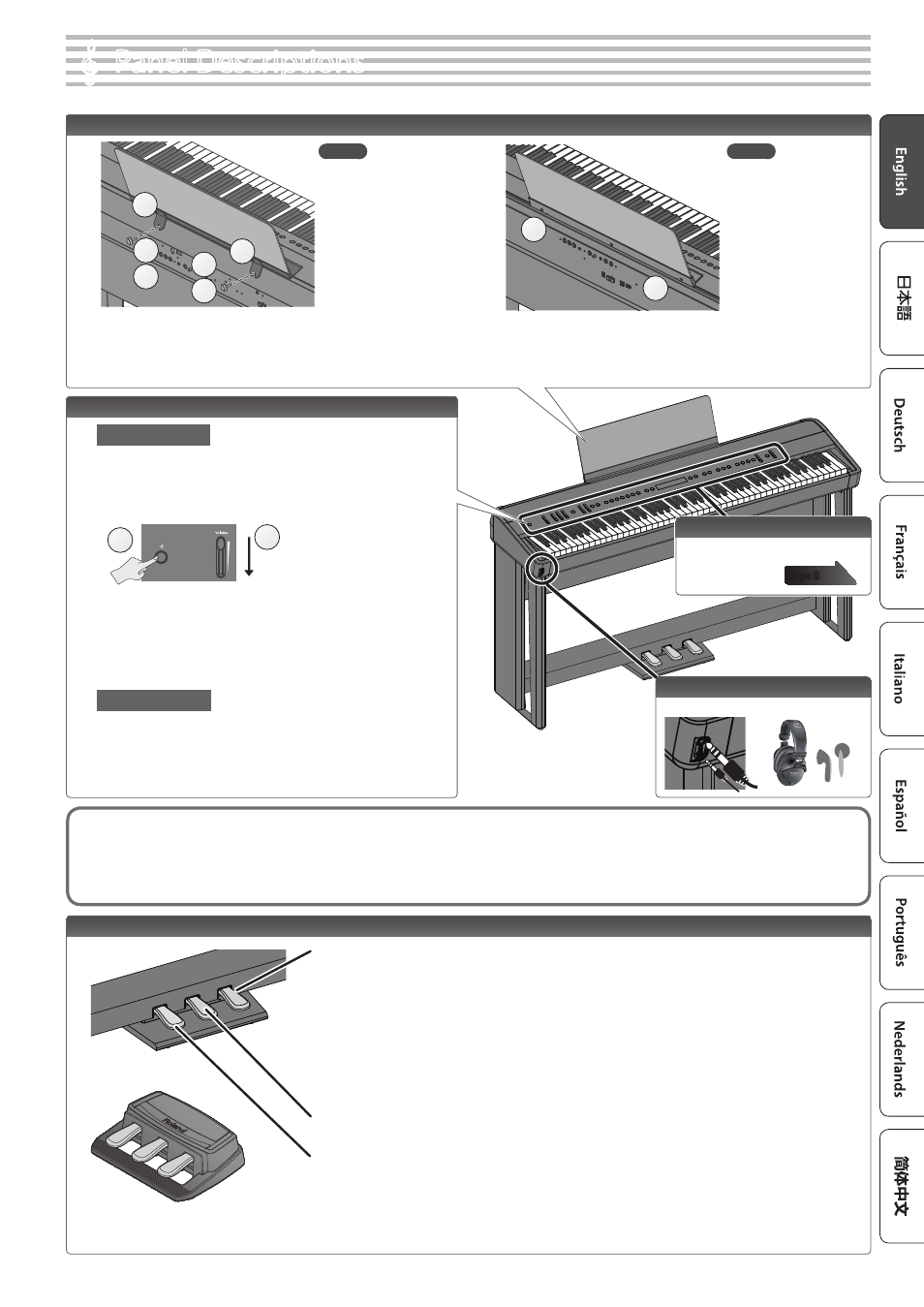Panel descriptions, Pedals (kpd-90/rpu-3: sold separately), Front panel – Roland FP-90X Portable Digital Piano (Black) User Manual
Page 5: Attaching the music rest, L ] button, Headphone jacks

5
°
Panel Descriptions
Damper Pedal
Use this pedal to sustain the sound. While this pedal is held down, notes will be sustained for an extended time even if you release your
fingers from the keyboard.
On an acoustic piano, when you step on the damper pedal, you’ll first hear the sound of the dampers releasing the strings.
Then, you should also be able to hear the sound of strings adjacent to the ones for the notes actually played resonate sympathetically,
resulting in a rich, resounding tone.
Additionally, when using half-pedaling techniques, the core of the sound disappears rapidly while a rich, spacious resonance remains,
producing a unique form of reverberation. On the unit, the unique, lingering tones produced by the half-pedaling technique are
reproduced in addition to released-string sounds (Damper Noise) and resonating sounds (Damper Resonance).
With the damper pedal on an acoustic piano, when you step on the pedal it will at first offer only a slight amount of resistance, but as
you press down further it will start to feel much heavier. On KPD-90, this change in the feeling of resistance is simulated.
Sostenuto Pedal
The notes you are pressing when this pedal is depressed will be sustained.
Soft Pedal
This pedal is used to make the sound softer. Playing with the soft pedal depressed produces a sound that is not as strong
as when otherwise played with the equivalent strength. This is the same function as the left pedal of a grand piano. The
softness of the tone can be varied subtly by the depth to which you press the pedal.
Pedals (KPD-90/RPU-3: sold separately)
* When operating the pedal, take care not to pinch your fingers between the moving part and the body of the unit. Pay special attention to this when using the unit where
children are present.
RPU-3 (sold separately)
KPD-90 (sold separately)
Concerning the Auto Off function
The power to this unit will be turned off automatically after a predetermined amount of time has passed since it was last used for playing music, or its buttons or controls
were operated (Auto Off function). If you do not want the power to be turned off automatically, disengage the Auto Off function (p. 28).
5
Any settings that you are in the process of editing will be lost when the power is turned off. If you have any settings that you want to keep, you should save them beforehand.
5
To restore power, turn the power on again.
* The illustration
shows the FP-90X.
Front Panel
This is where you operate the unit.
Attaching the Music Rest
2
1
1
2
3
3
1
Loosen the attachment screws
2
Fit the cut-outs of the music rest onto the attachment screws
3
Firmly tighten the attachment screws
1
1
1
Insert the music rest into the slit on the top of the piano
FP-90X
FP-60X
[
L
] button
Turning On the Power
* Before turning the unit on/off, always be sure to turn the volume down. Even
with the volume turned down, you might hear some sound when switching
the unit on/off. However, this is normal and does not indicate a malfunction.
1
Move the [Volume] slider all the way down to minimize the
volume
Minimize the volume.
2
1
2
Hold down the [
L
] button until the display shows “Roland Digital
Piano ”
The power turns on, and the tone buttons and other buttons
illuminate.
3
Move the [Volume] slider to adjust the volume
Turning Off the Power
1
Move the [Volume] slider all the way down to minimize the
volume
2
Hold down the [
L
] button until the display shows “Don’t
disconnect the power ”
The unit is turned off.
Headphone Jacks
Connect headphones (sold separately) here.
